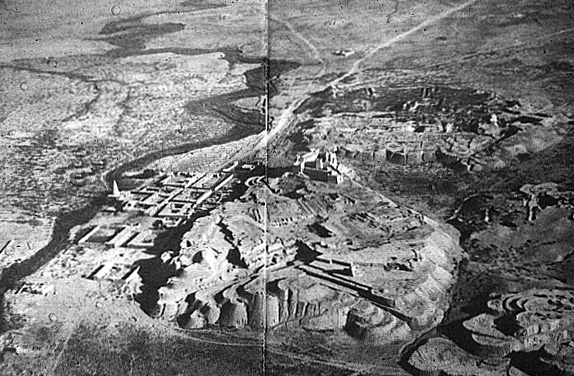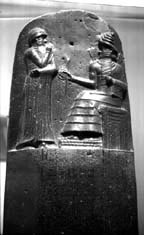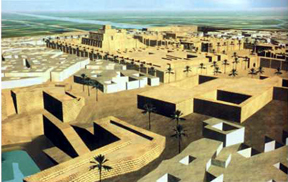|
|
![]()

Ration
Bowl: one
of the most telling artifacts in the assemblages of Sumerian urban sites is the
ubiquitous ration bowl, a hastily worked, gray ceramic bowl with an angled or
beveled rim. These bowls were typically mold-made, of uniform size, and
produced in large quantities. Ration bowls were used to distribute food rations
to members of large autonomous units known as households, making these the fundamental building blocks of the
Sumerian urban revolution.
Artist's Reconstruction of Ur III

Zigurat at Ur III Artwork
by John Hill
In southern
Mesopotamia temples stood at the center of communities and played a crucial
role in their development, with the architectural form of the ziggurat
representing a culminating monumental achievement. A ziggurat was a monumental
structure standing on a high platform that evolved from earlier structures of
the Ubaid period. The temple consisted of a long central room containing an
altar and offering tables with several smaller rooms accessible along the
longer sides of the building. Given the limited durability of sun-dried mud
brick, the exterior walls of the temples were reinforced by symmetrically
arranged buttresses. The surfaces of the exterior walls were often decorated
with mosaic arrangements of painted clay cones or nails set in the walls.

Susa, a good example of a partially excavated Mesopotamian Tel from the air. Capital of the Elamites.

Nineveh. An artistic rendering of the ancient Assyrian capital and religious center. Notice the Ziggurat (step pyramid structure) at the far left.

Life-rendering of a bronze bust of an Akkadian ruler, either Sargon or Naram Sin, found at Nineveh.
Artwork by John Hill

Hammurabi's Law Code, the steorite stele found at Susa. Hammurabi was the Babylonian (Amorite) King who ruled c. 1750 BC. He enacted a set of laws based on Mesopotamian precedents and later had them inscribed on this stele. Now in the Louvre Museum.

Behistun†††† Photo by Elizabeth Rauh
DECIPHERMENT OF
CUNEIFORM, the Behistun Inscription. The accomplishments
or Res Gestae of the Persian emperor, Darius I were inscribed 100m above the
base of a limestone cliff face on a large mountain situated at the gate to one
of the passes leading from Mesopotamia into Iran (on Mt. Behistun
[Bisutun] near the
city of Kermanshah in western Iran).
Inscribed sometime between 522 and 519 BC, the inscription records Dariusí
rise to power after having suppressed multiple rebellions through nineteen
military victories in the course of a single year. The text is inscribed in
three languages: Old Persian, Elamite, and Babylonian-Akkadian. Above the
inscription stood a life-sized bas-relief of Darius I, the Great, holding
a bow as a symbol of kingship, with his left foot pressing down on
the chest of a figure representing one of his vanquished rivals. Darius is
attended to the left by two military assistants; to the right nine smaller
figures bound as prisoners with rope around their necks and hands represent
various conquered peoples. The winged figure Faravahar (a symbol of the
divine blessing of the Zoroastrian god Ahuramazda)
flies above scene, anointing the king. The relief was apparently emended to
include an additional captured figure as well as Darius's own beard, attached
to the relief as a separate stone block with iron pins and lead.
We owe our understanding of the cuneiform script to Sir Henry Rawlinson, a
British officer and classicist who carefully recorded the inscribed text of the
royal inscription of King Darius I of Persia at Behistun
in 1838. At considerable risk to his own person Sir Henry Rawlinson reportedly
scaled the face of the cliff using ropes and planks to carefully transcribe the
inscribed texts. Rawlinson and others were able to use the knowledge of Avestan (the form of Sanskrit employed in Persia) to
decipher the cuneiform version of the text.
[The link bar feature is not available in this web]
